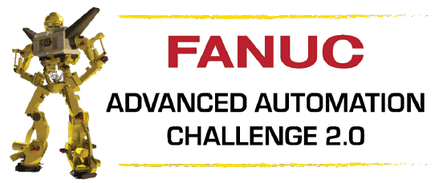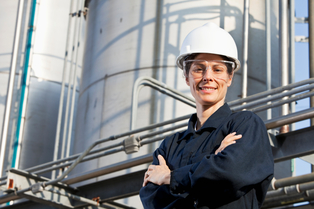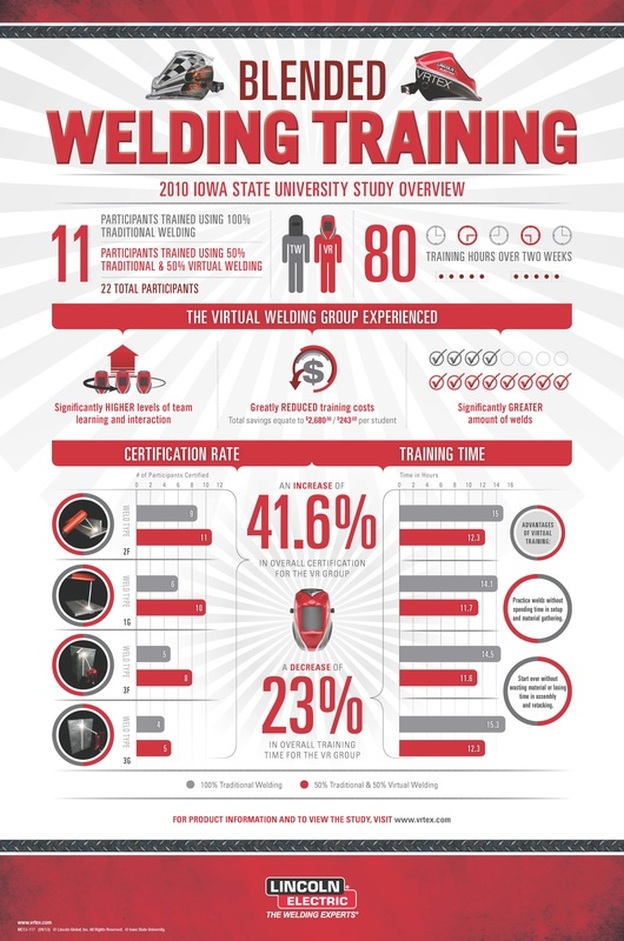 The FANUC Advanced Automation Challenge 2.0 invites all CERT schools to work with local industry to create problem solutions. This challenge provides students the opportunity to improve their STEM skills and become familiar with the advanced manufacturing industry. This challenge encourages students to work with manufacturers to design a solution or solve a problem using FANUC products or an integrated solution with technology from FANUC, Rockwell, Cisco or Lincoln. Students (aka “Tomorrow’s Innovators”) will have the opportunity to test their STEM (science, technology, engineering, math) skills and critical thinking abilities. Students will interview a manufacturer to learn about their processes and consider potential opportunities to apply their skills and knowledge. Students will use their school’s robot, CNC, or advanced manufacturing technology to develop/design a workable solution and provide a demonstration. Creativity is encouraged - students decide how simple or complex their solution is. The goal of this open-ended challenge is to change the perception of what todays advanced manufacturers looks like and introduce manufacturers to Tomorrow’s Innovators. This challenge will prepare them for exciting STEM career opportunities, develop their problem-solving skills, and introduce them to real-world advanced manufacturing applications. Manufacturers need a workforce that is prepared to work in the new, Smart Factories of Industry 4.0. FANUC, together with Rockwell Automation, Cisco Systems, and Lincoln Electric, are committed to supporting education programs that serve the needs of the advanced manufacturing industry. Awards will include a FANUC Robot, a FANUC CNC Simulator, a Rockwell PLC/HMI package, FANUC Simulation software, and technology from Cisco and Lincoln, representing over $100,000 investment in STEM education programs.
0 Comments
If you have a FANUC CERT program, you already know the benefits of adding robotics to your training programs. With FANUC America's educational products, students can learn to utilize the latest automation technology in robots, CNC, ROBODRILL, and integrated solutions while applying science, technology, engineering, and math (STEM) skills. Some of the successful approaches used by educational institutions are:
Are you getting the most out of your robotics program? Maximize your program with one or more of the following tools:
These are just a few of the options available for FANUC CERT training programs. Let us help you customize and enhance your program, while improving student outcomes. Contact Moss today for competitive pricing. Finding the right career fit is a challenge most students face and when asked what they want to do professionally when they graduate, the choices can be overwhelming. As a way to ease the transition for students making strides to their prospective career pathway, CEV Multimedia announces the addition of the Career Cluster Interest Inventory (CCII) tool to its comprehensive iCEV platform. The CCII provides assistance to students from eighth grade to higher education during the critical steps of education and career planning. A student completes the interest inventory within a 15- to 20-minute time period and receives information on a career cluster that best fits the student’s interests and skills. Career clusters, 16 groupings of related occupations developed by the U.S. Department of Education, provide essential knowledge and skills to guide in developing programs of study to bridge secondary and postsecondary curriculum. The clusters also assist in creating individual student plans of study for a complete range of career options. "This is an important addition to the CTE curriculum offered through iCEV that will assist students and educators alike in studying and exploring various career paths by identifying an interest pattern based on responses of career and activity related questions," said Dusty Moore, iCEV President. "Additionally, schools value survey tools to gain an understanding of the courses they need to offer to meet their students' needs and career aspirations."
Upon completing the inventory and being matched with a cluster, students are guided to post-secondary information and specific occupations. CCII complements the current iCEV career curriculum nicely as it allows a student to complete the interest inventory, identify their top cluster choices, then dive into the curriculum to watch videos, listen to industry experts via career interviews and complete projects to provide a better understanding of the clusters. After completing the study, students take a post-evaluation survey to see how their work impacted their original decisions. "The Career Cluster Interest Inventory enriches what we can offer to iCEV users and better connects them to the best education path leading towards their career choice," Moore said. "Students are able to look for general information on their career interests, as well as seek specific career titles, the credentials needed and college majors." Developed by CEV Multimedia, iCEV offers practical, interactive learning with professional demonstrations to prepare students for postsecondary education and high-skill, high-demand careers. Educators can quickly monitor, track and engage students directly through the platform’s interactive lessons. Through iCEV, students can also enhance their career training with industry-backed certifications. 6 Ways Iowa State University’s Metal 3D Printer is Transforming Manufacturing in Iowa (and Beyond)2/19/2016 Iowa State University recently unveiled its new metal 3D printer, a ProX 300 from 3D Systems, to the world. Since then, many people are learning about the advantages of adopting metal 3D printing as part of the design and manufacturing process.
Iowa State has opened its doors and invited people to learn with them as they navigate this new technology. “We’re doing a lot of this research that no one can do at this point because the technology’s not out there yet,” said Dakota Morgan, a graduate student researcher. 6 Ways ISU’s Metal 3D Printer is Transforming Manufacturing
Learn more about the ProX 300 at Iowa State University:  It’s 2015 – the “future” that Back to the Future dreamed about almost 30 years ago. While we don’t have hover boards or self-lacing tennis shoes, we have made some important advances – especially in the classroom. No class has changed more over the last 30 years than Career and Technical Education. In 1985, Career and Technical Education would have been known as “wood shop” or “metals” or “shop class.” In 2015, CTE classrooms have taken a decidedly different spin – and are a vital part of today’s education. So, what will CTE education look like in the next 30 years? Emphasis on Technology In the next 30 years, CTE will rely more heavily on technology – whether computer coding, robotics, or drafting work, technology will play a significant role in technical education. Hands on will always be important, but the way we deliver hands on education are changing today. In 30 years, we will rely more on 3D virtual reality for our education, where students will be able to learn a wider variety of subjects with a single piece of technology. (The future is closer than we think - check out zSpace for next level technology!) New Innovation In the next 30 years, 3D printing (or additive manufacturing) will be more prominent when designing and developing new models. Students will be familiar with computer design, and have a greater understanding of how math and visual design work together in the design process. Educators will place a greater emphasis on building knowledge and skills early. In the future, math skills will not only be taught in math class, but taught in the CTE wing as well. As a result, students will have a greater understanding of the hands on applications of math (and other STEM subjects). A Greater Umbrella Gone are the days when “CTE” refers only to wood shop. As Career and Technical Education transforms, so do the classes in the CTE wing: CTE can refer to computer programming, to welding, to Business and Marketing, Family and Consumer Science, or Renewable Energy education. In the future, CTE will take on a greater emphasis in career planning and education, making education more customized and efficient for all students. Many schools are already encouraging students to take classes in the CTE wing because it encourages K-12 students to prepare for careers after high school. Through the Test of Time Some technologies are tried and true – and the skills will always be relevant. Skills like welding, laser cutting and engraving, and industrial certification training will stand the test of time. These skills will remain relevant, even though techniques will evolve as the need for these skills changes. Do you need help bringing your CTE programs into the future? Are you looking for ideas to bring your current program into the 21st Century? Our Secondary Education Specialist is here to help – Contact Dan Sorenson for tools and ideas. “You go into high school and everyone is talking to you about, well, you have got to go to college to be successful and you have to go to a four-year university, you will be nothing without a bachelor’s degree. It really puts so much pressure on your shoulders to do well at everything you do. And in high school, that was a really hard thing to deal with.” - Keihen Kitchen, student Like many students, Kitchen was looking for real, hands-on career opportunities. She was encouraged to attend a four-year university when a two-year technical school gave her the opportunities and the skills she needed for success in the engineering field.
She found an ideal program for her needs at Cuyahoga Community College in Cleveland, a school that uses Amatrol to teach industry-ready skills. They work closely with the local industries when developing coursework, and turned to Amatrol for the programs that aligned with the needs of the local workforce. Students like Kitchen are benefiting from being job ready with a two-year degree. Community Colleges and Technical Schools are filling an important niche in today’s workforce by offering targeted skills training programs that align with local business need. It’s a win-win for students and local industry alike. When the right curriculum is in place, whether welding programs, skills training or otherwise, students join the workforce prepared for the local job market. Students know they have stackable credentials, and employers can feel confident in the knowledge base of their new hires. Remind students that there are many paths to success. Read the full transcript of the program here:  Your students have something to say about the direction their education is taking. Believe it – more students are taking an active role in crafting the direction of their training opportunities. Your students want to tell you a few things about the curriculum you choose. In this fast-paced, high-tech, consumer-driven world, students want to know that what they are learning today will be relevant in the real world. They also care about HOW they learn, and how you could make it better for them. (Here’s a hint: they prefer simulators in most situations!) Here are the top six things they have to say: “We learn just as effectively on a simulator as we do on the real thing.” Many educators worry that simulators aren’t life-like, and won’t provide adequate training for real situations. However, simulators have taken a page from the gaming industry and have built better graphics into modern-day simulators, making the simulations more true and engaging than ever before. Need proof? Check out the simulation on SimLog’s Forklift series here. “We need your feedback more than ever.” Whether you are using a welding simulator, a heavy equipment simulator, or something to teach pneumatics, simulation can play a key role in the education process. As an educator, you can identify specific opportunities for improvement at the spot where the student missed the target. Often, you can download a record of the simulation and coach directly to a student’s need. “We will be more engaged with the use of technology.” Integrating technology into the classroom drives engagement. Students today have grown up with laptops, smart phones, and mobile devices. They learn through the use of technology – classrooms are adapting to suit the way students learn benefits the student’s final outcomes. “The same tool can be used with multiple students.” Every educator is looking for a cost-effective way to replicate the same education from student to student. Furnishing each student with one-and-done supplies gets costly, and takes up storage space that a lot of schools don’t have. Tools like zSpace and CyberScience allow you to replicate the same dissection for multiple students – without sourcing dissection materials for each student. “We still get the hands on experience.” Many schools are afraid that the hands on experience will be lost with simulation software. However, the opposite is the case – when a school uses simulation software to teach the fundamentals, they can provide a much more meaningful experience for students who pursue advanced coursework. “We get it – budgets are tight.” Simulators are cost-effective – meaning that they can produce results with a much price tag. Students pursuing a variety of subject matters, though, can benefit from cost-effective simulation. From science to heavy machinery, there are simulators appropriate for the inquiring student, and can positively affect student outcomes. Simulators provide a more cost-effective, more sustainable alternative to the old methods. Ready to investigate? Check out Moss' cost-effective simulation options: Have you used simulation in your classroom? Tell us about it in the comments section!
Entering its second century, the welding profession is maturing, with many employers requiring more exposure to robotic automation, advanced equipment, exotic materials, specialized code certification, theory, welding procedure specifications and more. With advances and specialization, there is a growing need for welders who understand more than how to hold a torch and join metal. As a result, public, private and skilled trade schools at every level are developing new education programs to designed to deliver the workforce industry is demanding today to remain globally competitive. In parallel, the need for skilled welding instructors and appropriate curriculum is growing as workforce development partnerships take hold and federal and state grant funds become available. 7 Essential Components of a Successful Welding Program 1. Curriculum – A well-designed welding program will include curriculum that covers technique, industry trends, and introductions to the different areas of welding. 2. Training Equipment – welding is a hands-on course, so real world training opportunities are a must. Training equipment should include an introduction to ARC welding, TIG welding, MIG welding, and FCAW welding. 3. Welding Safety -- For an ARC welder, safety practices and personal protective equipment, when used properly, protect against potential hazards. A robust training program will inform and remind students about safe shop welding practices. 4. Hands-On Practice – Many welding programs teach with a mix of virtual and hands-on training. Welding simulators, like the RealWeld Trainer will teach essential skills in a controlled environment, while Robotic Education Cell 2.0 will educate students on robotics in welding. 5. Apprenticeship Opportunities – Different techniques widely vary in the field. Pairing an inexperienced welder with a more seasoned professional will allow students to gain industry knowledge while working toward certification. Apprenticeships often set up long-standing mentor relationships. 6. Certification – industry recognized credentials, like certifications offered by Lincoln Electric, will add credibility to students as they enter the workforce. 7. Career Connections – According to Chron, welders have a strong career outlook in the coming years, anticipating 15% growth in the field. Welding programs should have strong ties to the local workforce and supply a steady stream of qualified labor to local employers. Welding programs are a significant part of Career and Technical Education. Need help assessing your program? Contact Moss for a free consultation or to set up a live demonstration*.
*Demonstrations available in Iowa, Illinois, Nebraska and South Dakota.  “Consider the reality of today’s job market. We have a massive skills gap. Even with record unemployment, millions of skilled jobs are unfilled because no one is trained or willing to do them.” -Mike Rowe Mike Rowe definitely has a point. There are a lot of misconceptions about skilled labor today – that it’s a career consolation prize or for people not right for college. It’s time to debunk those myths, and help students understand that skills trades are valuable and necessary in today’s world. At Moss, we’re here to help you debunk some of the myths for your students (and clear up a few myths you may have). Myth #1 – Students are Not Enrolling in CTE Programs From 3D Printing to Mechatronics to Hydraulics and Pneumatics programs, career and technical educational positions are in high demand. Whether students are learning skills in a high school CTE program, transitioning to college coursework, or are workers looking for more advanced skills to further their careers, skilled trades are in high demand, especially in the heartland where manufacturing drives the workforce. Myth #2 – Skilled Labor jobs = Factory Work Skilled labor can mean factory work, yes, but the skills needed to excel in these positions are also required for work in agriculture, aerospace, civil engineering, mechanical drafting, medical technicians, nuclear technicians, robotics engineers and many more. With the right training and skill set, a technical degree can definitely take students off the factory floor. Myth #3 – Students can’t make a living with Skilled Lab positions Contrary to popular belief, skilled labor positions are some of the most high-paying entry-level positions today. People with the right skills are in high demand and can command an impressive starting salary upon graduation. Take a look at the Bureau of Labor Statistics Occupational Outlook Handbook for the following positions, or search a field of study here. Electro-mechanical Technicians Environmental Engineering Technicians Industrial Engineering Technicians Myth #4 – All Skilled Labor Jobs are the Same Skilled labor positions range from construction workers, plumbers, and electricians to robotics operators, mechatronics operators to engineers. Skilled labor is an umbrella term that blankets a very broad field. The variety of work is endless; and the skills are transferable. For example, a wind energy technician has mastered skills in hydraulics and pneumatics, and can turn around and use those skills in construction, agriculture, machine tools, wood processing, offshore, or aerospace fields (to name a few). A student can create their own path once they have mastered these 21st century skills. Myth #5 – Once a Student Learns a Skill, they are “Stuck” for the Rest of their Careers When a student learns a skill set, there is a lot of mobility to apply those skills to other fields as the need arises. In the case of the wind energy technician, above, a student has almost endless opportunities for high-paying positions in a variety of fields. Myth #6 – Skilled Labor Programs are Expensive for the College and the Student Though some programs require a greater initial investment, high schools and colleges can provide programs that are low-cost and highly effective. From Forklift Operation to pneumatics training, simulation programs provide an affordable alternative to other training programs. When looking for new classroom tools and curriculum, it’s helpful to look for certification programs that offer certifications so you can rest assured that your students are learning the right job-ready skills. Do you offer the right curriculum to help your students succeed? Take this 6 Question Quiz to find out: How does your program stack up? Let us know in the comments section!
|
AuthorYou have questions about STEM education? You're not alone! We're here to share ideas and provide thought-provoking commentary. Let us know your thoughts! Sign Up for Email Updates For Email Marketing you can trust. Categories
All
Archives
February 2017
|
- Home
-
K-12
- College
- Industry
- Certifications
-
Partners
- Afinia-3D Printing
- Amatrol-Manufacturing Training Equipment
- Apolo Studios- Welding Simulation
- Bantam Tools - CNC
- CEF-Custom Educational Furniture
- DAC Worldwide-Manufacturing Training Equipment
- Greene Manufacturing Inc - Furniture
- Iconic CNC
- Interior Concepts-Furniture
- MSSC Certifications
- MINDS-i Education
- Pitsco Education-STEM
- SimLog-Heavy Equipment Simulation
- Stokes Robotics
- Techno CNC Systems
- Universal Laser Systems
- VictoryXR - Virtual Reality
- WB Mfg - Furniture
- Funding
- Contact
- About
- Home
-
K-12
- College
- Industry
- Certifications
-
Partners
- Afinia-3D Printing
- Amatrol-Manufacturing Training Equipment
- Apolo Studios- Welding Simulation
- Bantam Tools - CNC
- CEF-Custom Educational Furniture
- DAC Worldwide-Manufacturing Training Equipment
- Greene Manufacturing Inc - Furniture
- Iconic CNC
- Interior Concepts-Furniture
- MSSC Certifications
- MINDS-i Education
- Pitsco Education-STEM
- SimLog-Heavy Equipment Simulation
- Stokes Robotics
- Techno CNC Systems
- Universal Laser Systems
- VictoryXR - Virtual Reality
- WB Mfg - Furniture
- Funding
- Contact
- About









 RSS Feed
RSS Feed
